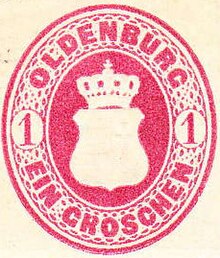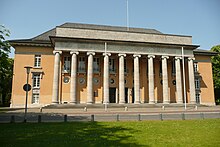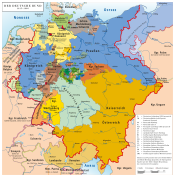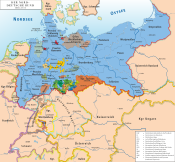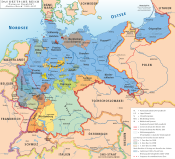
Lower Saxony is a German state in northwestern Germany. It is the second-largest state by land area, with 47,614 km2 (18,384 sq mi), and fourth-largest in population among the 16 Länder of the Federal Republic of Germany. In rural areas, Northern Low Saxon and Saterland Frisian are still spoken, though by declining numbers of people.
Friesland is a district (Landkreis) in Lower Saxony, Germany. It is bounded by the districts of Wesermarsch, Ammerland, Leer and Wittmund, and by the North Sea. The city of Wilhelmshaven is enclosed by—but not part of—the district.
The district of Oldenburg is a district in the state of Lower Saxony, Germany. It is bounded by the districts of Diepholz, Vechta, Cloppenburg and Ammerland, the city of Oldenburg, the district of Wesermarsch and the city of Delmenhorst.
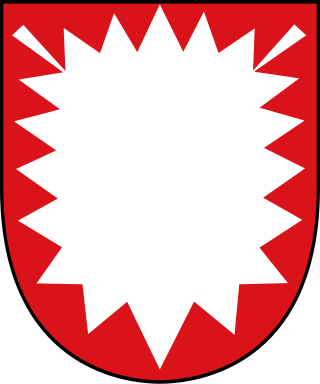
Holstein is the region between the rivers Elbe and Eider. It is the southern half of Schleswig-Holstein, the northernmost state of Germany.

The Duchy of Oldenburg, named for its capital, the town of Oldenburg, was a state in the north-west of present-day Germany. The counts of Oldenburg died out in 1667, after which it became a duchy until 1810, when it was annexed by the First French Empire. It was located near the mouth of the River Weser.

The Oldenburg Münsterland, otherwise called Oldenburger Münsterland or Oldenburgisches Münsterland, is a region in Lower Saxony, Germany and the administrative area that comprises the federal districts of Cloppenburg and Vechta. It forms the southern part of the historical region of Oldenburg Land, so it is also called Südoldenburg. The inhabitants of the region accordingly call themselves Südoldenburger, with the denominative Oldenburger Münsterländer being rather uncommon.

The Duchy of Saxe-Lauenburg, was a reichsfrei duchy that existed from 1296 to 1803 and again from 1814 to 1876 in the extreme southeast region of what is now Schleswig-Holstein. Its territorial center was in the modern district of Herzogtum Lauenburg and originally its eponymous capital was Lauenburg upon Elbe, though the capital moved to Ratzeburg in 1619.

Land Wursten is a former Samtgemeinde in the district of Cuxhaven, in Lower Saxony, Germany. It was situated approximately 20 km (12 mi) southwest of Cuxhaven, and 15 km (9.3 mi) north of Bremerhaven. Its seat was in the village Dorum. It was disbanded in January 2015, when its member municipalities merged into the new municipality Wurster Nordseeküste.

Peter I or Peter Frederick Louis of Holstein-Gottorp was the Regent of the Duchy of Oldenburg for his incapacitated cousin William I from 1785 to 1823, and then served himself as Duke from 1823 to 1829.

The Prince-Bishopric of Lübeck, was an ecclesiastical principality of the Holy Roman Empire until 1803. Originally ruled by Roman-Catholic bishops, after 1586 it was ruled by lay administrators and bishops who were members of the Protestant Holstein-Gottorp line of the House of Oldenburg. The prince-bishops had seat and vote on the Ecclesiastical Bench of the College of Ruling Princes of the Imperial Diet.
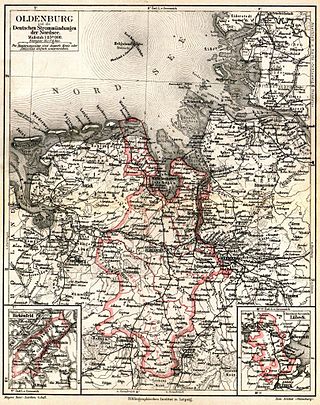
The Grand Duchy of Oldenburg Railway was the railway company that was run as a state railway for the Grand Duchy of Oldenburg, part of the German Empire.
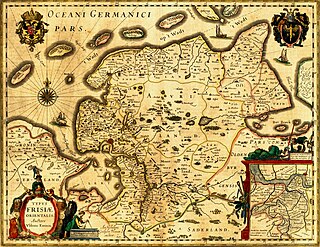
The County of East Frisia was a county in the region of East Frisia in the northwest of the present-day German state of Lower Saxony.

The coat of arms of Oldenburg is the coat of arms associated with the state of Oldenburg, a county, duchy and then grand duchy that existed between 1101 and 1918. The arms are also associated with the parts of the House of Oldenburg that ruled the state.
Christian, Duke of Oldenburg is the head of the Grand Ducal Family of Oldenburg.
Eric IV of Saxe-Lauenburg was a son of Eric II, Duke of Saxe-Lauenburg and Agnes of Holstein.
Eric V of Saxe-Lauenburg was a member of the House of Ascania; son of Duke Eric IV of Saxe-Lauenburg and Sophia of Brunswick-Lüneburg. Eric V and his brother John IV jointly succeeded their father in 1412 as dukes of Saxe-Lauenburg. After John IV had died in 1414, Eric ruled alone.

The Principality of Brunswick-Wolfenbüttel was a subdivision of the Duchy of Brunswick-Lüneburg, whose history was characterised by numerous divisions and reunifications. It had an area of 3,828 square kilometres in the mid 17th century. Various dynastic lines of the House of Welf ruled Brunswick-Wolfenbüttel until the dissolution of the Holy Roman Empire in 1806. As a result of the Congress of Vienna, its successor state, the Duchy of Brunswick, was created in 1815.
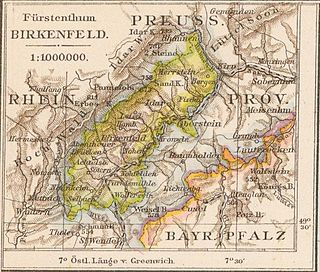
The Principality of Birkenfeld, known after 1919 as the Region of Birkenfeld, was an exclave of the Grand Duchy and then the Free State of Oldenburg from 1817 until 1937, when it was incorporated into Prussia. It was located in the Nahe region on the left bank of the Rhine river and its capital was Birkenfeld. The government was led by a Government-President (Regierungspräsident) who was appointed by the government of Oldenburg.

The Principality of Ratzeburg is a former state, existing from 1648 to 1918. It belonged to the imperially immediate territory of the Duchy of Mecklenburg within the Holy Roman Empire. It was formed from the territory of the former Prince-Bishopric of Ratzeburg, which was secularised to Mecklenburg-Güstrow in the 1648 Peace of Westphalia. Following the death of the last duke in 1695, the territories of Mecklenburg-Güstrow were split up in the 1701 Treaty of Hamburg, which created the semi-ducal states of Mecklenburg-Schwerin and Mecklenburg-Strelitz, with the latter made up of the Principality of Ratzeburg and the Lordship of Stargard. Its territories remained exclaves of Mecklenburg-Strelitz through its later iterations – the Grand Duchy from 1815 and Free State from 1918 – before the bulk of it was finally incorporated into the unified state of Mecklenburg in 1934 as part of Landkreis Schönberg; its small exclaves were incorporated into Kreis Herzogtum Lauenburg of Schleswig-Holstein. Most of the Principality is now within the state of Mecklenburg-Vorpommern.


